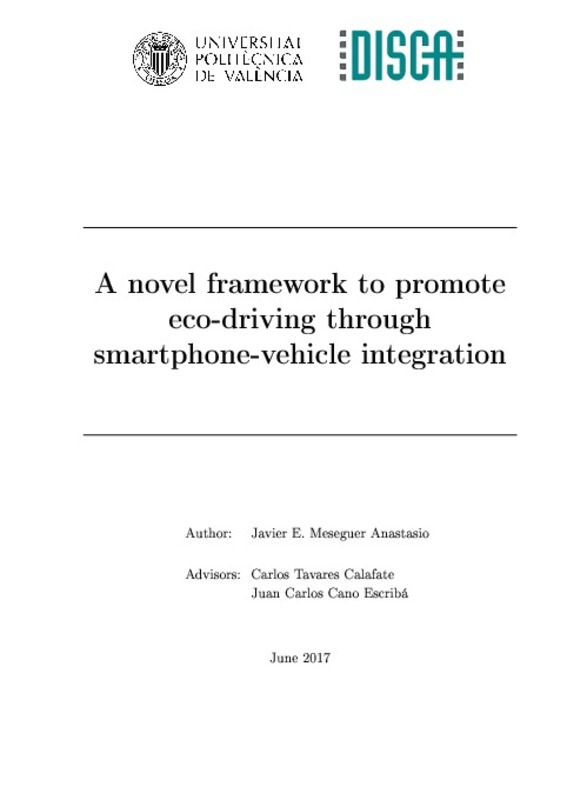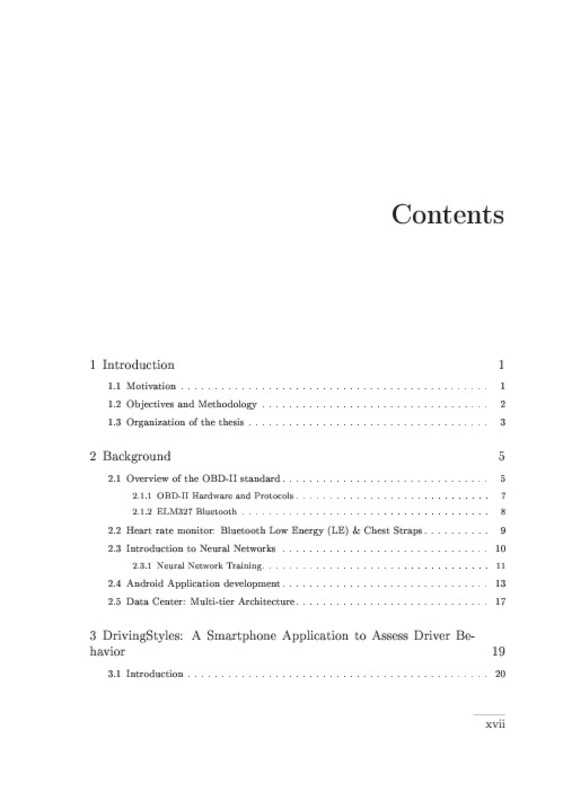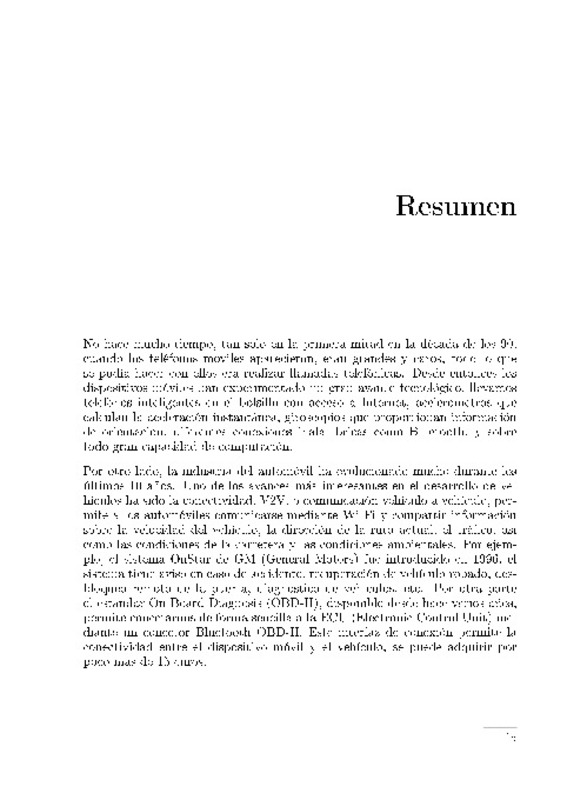- RiuNet repositorio UPV
- :
- Investigación
- :
- Tesis doctorales
- :
- Ver ítem
JavaScript is disabled for your browser. Some features of this site may not work without it.
Buscar en RiuNet
Listar
Mi cuenta
Estadísticas
Ayuda RiuNet
Admin. UPV
A novel framework to promote eco-driving through smartphone-vehicle integration
Mostrar el registro sencillo del ítem
Ficheros en el ítem
| dc.contributor.advisor | Cano Escribá, Juan Carlos
|
es_ES |
| dc.contributor.advisor | Tavares de Araujo Cesariny Calafate, Carlos Miguel
|
es_ES |
| dc.contributor.author | Meseguer Anastasio, Javier Enrique
|
es_ES |
| dc.date.accessioned | 2017-07-03T06:47:06Z | |
| dc.date.created | 2017-06-01 | es_ES |
| dc.date.issued | 2017-12-01 | es_ES |
| dc.identifier.uri | http://hdl.handle.net/10251/84287 | |
| dc.description | Tesis por compendio | es_ES |
| dc.description.abstract | It was not that long ago, just in the first half on the 1990s, when mobile phones were first introduced, being big and expensive. All you could do with them was to make phone calls. Since then mobile devices have experienced a great technological advance: we carry smartphones in our pockets that provide Internet access, having accelerometers that can measure acceleration, a gyroscope that can provide orientation information, different wireless interfaces such as Bluetooth connections, and above all, great computing power. On the other hand, the automobile industry has evolved significantly during the last 10 years. One of the most exciting advances in vehicle development is vehicle-to-vehicle V2V communication, which allows cars to communicate with each other over a dedicated Wi-Fi band, and share information about vehicle speed, route direction, traffic flow, and road and weather conditions. An example of such a system is GM's (General Motors) OnStar, introduced in 1996, and that provides automatic response in case of an accident, stolen-vehicle recovery, remote door unlock, and vehicle diagnostics. Also, the standard On Board Diagnosis (OBD-II), available for several years, allows us to connect to the Electronic Control Unit (ECU) via a Bluetooth OBD-II connector. This connection interface allows connectivity between the smartphone and the vehicle, and can be purchased for just over 15 euros. The spectrum of possibilities that arise when combining the car and the smartphone is unlimited, such as performing the diagnosis of the car by assuming the tasks performed by the car's On Board Unit (OBU), or sending the collected data to a platform where the diagnosis or maintenance of the system can be realized in order to detect possible faults, help you to save gas and reduce environment pollution, and notify you of your car's problems, among other features. The general objective pursued with this doctoral thesis is to help drivers to correct bad habits in their driving. To achieve this we promote the combination between smartphones and vehicular networks to design and develop a platform able to offer useful tips to achieve safer driving and greater fuel economy. It is well-known that intelligent driving can lead to lower fuel consumption, with the consequent positive impact on the environment. The proposal that has been carried out in this doctoral thesis begins with the data capture from the vehicles' OBD-II port and data analysis through the use of graphs, maps, and statistics, both, on the server itself and in the smartphone's application developed. We applied data mining techniques and neural networks to analyze, study and generate a classiffication on driving styles based on the analysis of the characteristics of each specific route used for testing. In a second phase, we demostrate the relationship between fuel consumption and driving style. To achieve that goal, the first thing that we had to realize was how to apply different algorithms for the instantaneous consumption calculation (this parameter cannot be obtained directly from the vehicle ECU). Later, we studied and analyzed all data that was collected from the drivers who shared their monitored data with the server. Although drivers do not recognize themselves as being in a state of anxiety while driving, they are more stressed than in any other daily activity, for example, when trying to stay in the right lane, keeping the car at a certain speed, and starting and stopping the vehicle. In general, drivers are more concentrated than they think, which causes an increase in the heart rate. Many factors influence heart rate while at rest, e.g. stress, medications, medical conditions, even genes play a role. In our study we also investigate how stress and the driving behavior influence the heart rate. So, in the last phase, we demostrate the correlation between heart rate and driving style, showing how the driving style can make the heart rate vary by 3 %. | en_EN |
| dc.description.abstract | No hace mucho tiempo, tan sólo en la primera mitad en la década de los 90, cuando los teléfonos móviles aparecieron, eran grandes y caros, todo lo que se podía hacer con ellos era realizar llamadas telefónicas. Desde entonces los dispositivos móviles han experimentado un gran avance tecnológico, llevamos teléfonos inteligentes en el bolsillo con acceso a Internet, acelerómetros que calculan la aceleración instantánea, giroscopios que proporcionan información de orientación, diferentes conexiones inalámbricas como Bluetooth, y sobre todo, gran capacidad de computación. Por otro lado, la industria del automóvil ha evolucionado mucho durante los últimos 10 años. Uno de los avances más interesantes en el desarrollo de vehículos ha sido la conectividad, V2V, o comunicación vehículo a vehículo, permite a los automóviles comunicarse mediante Wi-Fi y compartir información sobre la velocidad del vehículo, la dirección de la ruta actual, el tráfico, así como las condiciones de la carretera y las condiciones ambientales. Por otra parte, el estándar On Board Diagnosis (OBD-II), disponible desde hace varios años, permite conectarnos de forma sencilla a la ECU (Electronic Control Unit) mediante un conector Bluetooth OBD-II. Este interfaz de conexión permite la conectividad entre el dispositivo móvil y el vehículo, se puede adquirir por poco más de 15 euros. El espectro de posibilidades que surgen al combinar el automóvil y el Smartphone es amplísimo, como por ejemplo realizar el diagnóstico del coche a través del móvil asumiendo las tareas que hace la unidad On Board Unit (OBU) del coche, o bien enviar los datos recogidos a una plataforma donde se pueda realizar el diagnóstico o mantenimiento del sistema, detectando posibles fallos puede ayudar a ahorrar en el consumo de combustible, notificar los problemas del coche en tiempo real, entre otras características. El objetivo general que se persigue con esta tesis doctoral es ayudar al conductor a corregir malos hábitos en su forma de conducción. Conseguimos esto mediante la combinación entre smartphones y las redes vehiculares, diseñamos y desarrollamos una plataforma capaz de ofrecer consejos útiles para conseguir una conducción más segura y un mayor ahorro de combustible. Es conocido que una conducción inteligente puede llevarnos a un menor consumo de combustible, con el consiguiente impacto positivo que ello conlleva sobre el medio ambiente. La propuesta que se ha llevado a cabo en esta tesis doctoral comienza con la obtención de los datos desde el OBD-II del coche y su presentación y análisis mediante el uso de gráficas, mapas, estadísticas, tanto en el propio servidor como en la aplicación móvil desarrollada para la obtención de datos recibidos desde la ECU. Se aplicaron técnicas de minería de datos y redes neuronales para analizar, estudiar y generar una clasificación sobre los estilos de conducción en base al análisis de las características de la vía sobre la que ha realizado la ruta. En una segunda fase se demostró la relación entre el consumo de combustible con el estilo de conducción, para ello lo primero que tuvimos que realizar fue aplicar diversos algoritmos para el cálculo del consumo instantáneo, este parámetro no es posible obtenerlo directamente de la ECU del vehículo. Posteriormente se realizó el estudio y el análisis de todos los datos que se recogieron de los conductores que se prestaron a la realización del estudio enviando los datos al servidor. Muchos factores influyen en la frecuencia cardíaca en reposo, por ejemplo, el estrés, los medicamentos, las condiciones médicas, incluso los genes tienen su influencia, el envejecimiento tiende a acelerarlo, y el ejercicio regular tiende a ralentizarlo. En nuestro estudio también investigamos cómo el estrés y el comportamiento en la conducción influyen en la frecuencia cardíaca. En la última fase vemos la correlación existente entre el ri | es_ES |
| dc.description.abstract | No fa molt de temps, tan sols en la primera mitat en la dècada dels 90, quan els telèfons mòbils van aparéixer, eren grans i cars, tot el que es podia fer amb ells era realitzar telefonades. Des de llavors els dispositius mòbils han experimentat un gran avanç tecnològic, portem telèfons intel_ligents en la butxaca amb accés a Internet, acceleròmetres que calculen l'acceleració instantània, giroscopis que proporcionen informació d'orientació, diferents connexions sense _ls com Bluetooth, i sobretot gran capacitat de computació. D'altra banda, la indústria de l'automòbil ha evolucionat molt durant els últims 10 anys. Un dels avanços més interessants en el desenrotllament de vehicles ha sigut la connectivitat, V2V, o comunicació vehicle a vehicle, permet als automòbils comunicar-se per mitjà de la banda de Wi-Fi i compartir información sobre la velocitat del vehicle, la direcció de la ruta actual, les condicions del trà_c, així com l'estat de la carretera i les condicions ambientals. D'altra banda l'estàndard On Board Diagnosi (OBD-II), disponible des de fa diversos anys, permet connectar-nos de forma senzilla a l'ECU (Electronic Control Unit) per mitjà d'un connector Bluetooth OBD-II. Esta interfície de connexió permet la connectivitat entre el dispositiu mòbil i el vehicle, es pot adquirir per poc més de 15 euros. L'espectre de possibilitats que sorgixen al combinar l'automòbil i el Smartphone és il_limitat, com per exemple realitzar el diagnòstic del cotxe a través del móvil assumint les tasques que fa la unitat On Board Unit (OBU) del cotxe, o bé enviar les dades arreplegades a una plataforma on es puga realitzar el diagnòstic o manteniment del sistema, detectant possibles fallades, ajuda a estalviar en el consum de combustible, noti_car els problemes del cotxe en temps real, entre altres característiques. L'objectiu general que es perseguix amb esta tesi doctoral és ajudar al conductor a corregir mals hàbits en la seua forma de conducció. Aconseguim açò mitjançant de la combinació entre smartphones i les xarxes vehiculares, dissenyem i desenrotllem una plataforma capaç d'oferir consells útils per a aconseguir una conducció més segura i un major estalvi de combustible. És conegut que una conducció intel_ligent pot emportar-nos a un menor consum de combustible, amb el consegüent impacte positiu que això comporta sobre el medi ambient. La proposta que s'ha dut a terme en esta tesi doctoral comença amb l'obtenció de les dades des de l'OBD-II del cotxe i la seua presentació i anàlisi per mitjà de l'ús de grà_ques, mapes, estadístiques, tant en el propi servidor, com en l'aplicació mòbil desenrotllada per a l'obtenció de dades rebudes des de l'ECU. S'apliquen tècniques de mineria de dades i xarxes neuronals per a analitzar, estudiar i generar una classi_cació sobre els estils de conducció basant-se en l'anàlisi de les característiques de la via sobre la qual ha realitzat la ruta. En una segona fase es va a demostrar la relació entre el consum de combustible amb l'estil de conducció, per a això la primera cosa que vam haver de realizar va ser aplicar diversos algorismes per al càlcul del consum instantani, este paràmetre no és possible obtindre-ho directament de l'ECU del vehicle. Posteriorment es va realitzar l'estudi i l'anàlisi de totes les dades que es van arreplegar dels conductors que es van prestar a la realització de l'estudi enviant les dades al servidor. Molts factors in_ueixen en la freqüència cardíaca en repòs, per exemple, l'estrès, els medicaments, les condicions mèdiques, _ns i tot els gens tenen la seua in_uència, l'envelliment tendeix a accelerar-ho, i l'exercici regular tendeix a ralentir-ho. En el nostre estudi només estem interessats en com l'estrès i el comportament en la conducció in_ueixen en la freqüència cardíaca. En l'última fase vam veure la correlació existent entre el ritme cardíac i l'estil de conducci | ca_ES |
| dc.language | Inglés | es_ES |
| dc.publisher | Universitat Politècnica de València | es_ES |
| dc.rights | Reserva de todos los derechos | es_ES |
| dc.subject | Driving styles | es_ES |
| dc.subject | Android | es_ES |
| dc.subject | smartphone | es_ES |
| dc.subject | OBD-II | es_ES |
| dc.subject | Wireless Network | es_ES |
| dc.subject | neural networks | es_ES |
| dc.subject | fuel consumption | es_ES |
| dc.subject | greenhouse | es_ES |
| dc.subject | gas emissions | es_ES |
| dc.subject | eco-driving | es_ES |
| dc.subject | driving habits | es_ES |
| dc.subject | road safety | es_ES |
| dc.subject | heart rate | es_ES |
| dc.subject.classification | ARQUITECTURA Y TECNOLOGIA DE COMPUTADORES | es_ES |
| dc.title | A novel framework to promote eco-driving through smartphone-vehicle integration | es_ES |
| dc.type | Tesis doctoral | es_ES |
| dc.identifier.doi | 10.4995/Thesis/10251/84287 | es_ES |
| dc.rights.accessRights | Abierto | es_ES |
| dc.contributor.affiliation | Universitat Politècnica de València. Departamento de Informática de Sistemas y Computadores - Departament d'Informàtica de Sistemes i Computadors | es_ES |
| dc.description.bibliographicCitation | Meseguer Anastasio, JE. (2017). A novel framework to promote eco-driving through smartphone-vehicle integration [Tesis doctoral]. Universitat Politècnica de València. https://doi.org/10.4995/Thesis/10251/84287 | es_ES |
| dc.description.accrualMethod | TESIS | es_ES |
| dc.type.version | info:eu-repo/semantics/acceptedVersion | es_ES |
| dc.relation.pasarela | TESIS\8702 | es_ES |
| dc.description.compendio | Compendio | es_ES |
Este ítem aparece en la(s) siguiente(s) colección(ones)
-
Tesis doctorales [5389]










